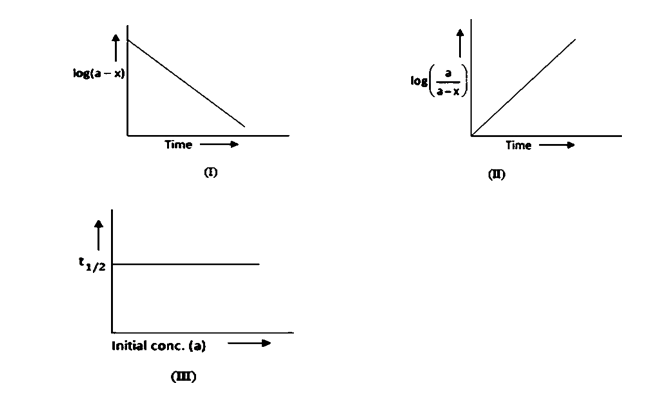Which of the following expression is correct for first order reaction? Ao refers to initial concentration of reactant
t1/2∝A∘
t1/2∝A−1∘
t1/2∝A−2∘
t1/2∝(A∘)0
The correct Answer is:D
To determine the correct expression for the half-life of a first-order reaction, we can follow these steps:
Step 1: Understand the first-order reaction rate equation
For a first-order reaction, the rate equation can be expressed as:
k=1tln((A0)(A))
where:
- k is the rate constant,
- (A0) is the initial concentration of the reactant,
- (A) is the concentration of the reactant at time t.
Step 2: Define the half-life
The half-life (t1/2) is the time required for the concentration of the reactant to decrease to half of its initial value. Therefore, at t=t1/2:
(A)=(A0)2
Step 3: Substitute into the rate equation
Substituting (A)=(A0)2 into the rate equation gives:
k=1t1/2ln⎛⎜⎝(A0)(A0)2⎞⎟⎠
Step 4: Simplify the logarithm
This simplifies to:
k=1t1/2ln(2)
Step 5: Rearrange to find half-life
Rearranging the equation to solve for t1/2 gives:
t1/2=ln(2)k
Step 6: Conclusion
From this expression, we can conclude that the half-life of a first-order reaction is independent of the initial concentration (A0). Therefore, the correct expression for the half-life of a first-order reaction is:
t1/2=ln(2)k
For a first-order reaction, the rate equation can be expressed as:
k=1tln((A0)(A))
where:
- k is the rate constant,
- (A0) is the initial concentration of the reactant,
- (A) is the concentration of the reactant at time t.
The half-life (t1/2) is the time required for the concentration of the reactant to decrease to half of its initial value. Therefore, at t=t1/2:
(A)=(A0)2
Substituting (A)=(A0)2 into the rate equation gives:
k=1t1/2ln⎛⎜⎝(A0)(A0)2⎞⎟⎠
This simplifies to:
k=1t1/2ln(2)
Rearranging the equation to solve for t1/2 gives:
t1/2=ln(2)k
From this expression, we can conclude that the half-life of a first-order reaction is independent of the initial concentration (A0). Therefore, the correct expression for the half-life of a first-order reaction is:
t1/2=ln(2)k
Similar Questions
Which of the following is/are correct for the first order reaction ? (a is initial concentration of reactant, x is concentration of the reactant reacted and t is time)

View SolutionWhich of the following expressions is correct for zero order respectively [Where a is initial concentration]?
View Solution
Knowledge Check
Which of the following expressions is correct for first order reaction? (a0 refers to initial concentration of reactant)
At1/2∝a00Bt1/2∝a−20Ct1/2∝a−10Dt1/2∝a0Which of the followoing expression is correct for first order reaction ? (CO) refers to initial concentration of reactant.
At1/2∝COBt1/2∝CO−1Ct1/2∝CO−2Dt1/2∝CO0Which of the following expresison is correct for first order reaction (c0 refers to initial concentration of reactant)
At1/2∝c0Bt1/2∝c−10Ct1/2∝c−20Dt1/2∝c00
For a first order reaction :
A→B with initial concentration =a
View SolutionWhich of the following relation is correct for a first order reaction?
(K=rate constant, r=rate of reaction, c = cone, of reactant)
View SolutionWhich of the following is correct for zero and first order reactions respectively, where 'a' is initial concentration of the reactant ?
View SolutionFor a first order reaction, if ‘a’ is the initial concentration of reactant, then the half life time is
View SolutionIn a first order reaction with time the concentration of the reactant decreases
View Solution

